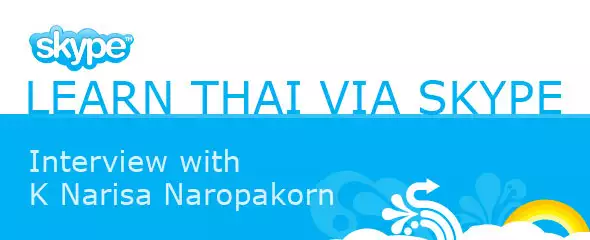

Cat, the famous creator of the Thai learning website womenlearnthai.com, interviewed me:

Khun Narisa, please tell us about your teaching background
I was born in Bangkok, therefore my accent is the Bangkok standard.
My late father was a journalist who also owned a bookstore, so as a child I had plenty of opportunity to read up on a wide range of subjects. In many way, my literary background paved the way for me to teach the Thai language to foreigners.
I graduated with an English Major (B.A.), and as a result, explaining the differences between Thai and English became a strong point in my teaching.
Later, I joined the U.S. language and cultural training program for Indochinese refugees in 1983 (The Consortium, Phanat Nikhom Chonburi, Thailand). Following the American method, I learned how to teach language and culture to adults.
I have been teaching Thai to foreigners for (19) years and I started teaching via Skype (7) years ago. With Skype I’ve been able to expand internationally.
What are the differences between teaching Thai and western students?
When I teach English to Thai students, I instruct them to enunciate the ends of their words. When I teach Thai to foreigners, I have to tell them to close their lips, faster than the wind; they have to complete with the wind.
For Thai students learning English, only 20% ask questions. The remaining 90% sit quietly, waiting for me to speak. But when teaching westerners, our roles are totally changes as they speak up first, and I’m the one listening quietly.
I’ve developed an interest in teaching methods and learning styles. So, how do you teach languages?
To understand how my students learn, I ask them to take one or two learning style tests: VAK and Myers & Briggs. And when I teach, I use my own learning style, which is a combination of visual and audio.
With Fleming’s VAK model, there are three main learning styles: visual, audio, and kinesthetic. I am mostly visual as I cannot learn with out seeing. My second strength is audio because I also learn while listening.
Wikipedia: Fleming’s VAK model is one of the most common and widely-used categorizations of the various types of learning styles. Fleming claimed that visual learners have a preference for seeing (think in pictures; visual aids such as overhead slides, diagrams, handouts, etc.) Auditory learners best learn through listening (lectures, discussions, tapes, etc.). Tactile/kinesthetic learners prefer to learn via experience—moving, touching, and doing (active exploration of the world; science projects; experiments, etc.). Its use in pedagogy allows teachers to prepare classes that address each of these areas. Students can also use the model to identify their learning style and maximize their educational experience by focusing on what benefits them the most.
If you are curious, take the test to see for yourself: VAK Learning Styles Test.
With each new student I start off using my natural teaching style. From past experience I know that the personality type I see most often is visual, so my style suits most students coming to me. And if my teaching style and the student’s learning style works well together, then I continue on no problem.
But with some students I find the need to adjust my teaching style. To get insight into how these types of students learn, I ask them to take the Myers-Briggs test. I do this because the student might miss out on 20-30% of the class if I don’t adjust my teaching style to suit their particular learning style. But I do not use Myers-Briggs with everyone, only in cases where I sense a need.
Myers & Briggs: Teachers who vary their teaching styles after learning about personality type often find they can motivate and teach a wider range of students, because they are appealing to all preferences.
If you are interested in finding out about Myers-Briggs, check out these resources:
- The Myers & Briggs Foundation: Type and Learning
- Team Technology: Myers Briggs Personality Type
- Wikipedia: Myers-Briggs Type Indicator
To teach, I follow the student-centered method explained in this article by Texas Collaborative:
Texas Collaborative: Student-centered teaching focuses on the student. Decision-making, organization, and content are largely determined by the student’s needs and perceptions. Even assessment may be influenced or determined by the student. The instructor acts as coach and facilitator. In many respects, the goal of this type of teaching is the development of the student’s cognitive abilities… student-centered teaching leads to “better retention, better transfer of knowledge to other situations, better motivation for further learning, and better problem–solving abilities… Active participation by students helps them construct a better framework from which to generalize their knowledge.
This article is originally posted on expatden.com